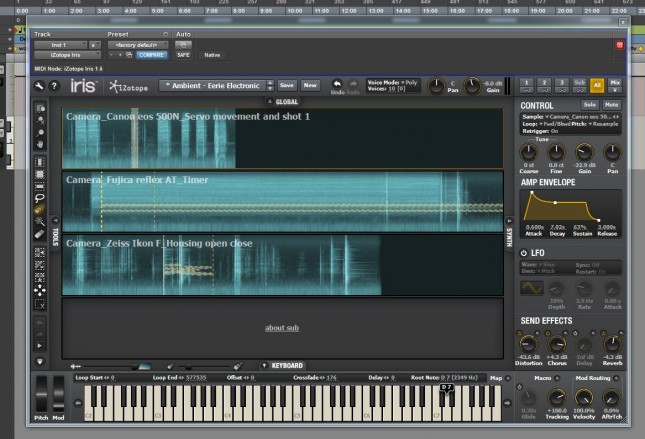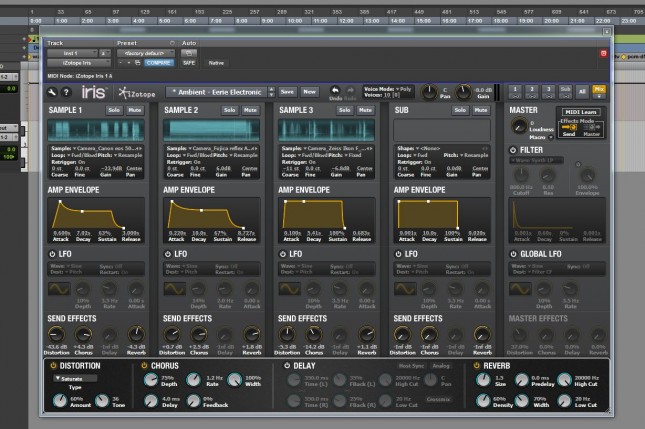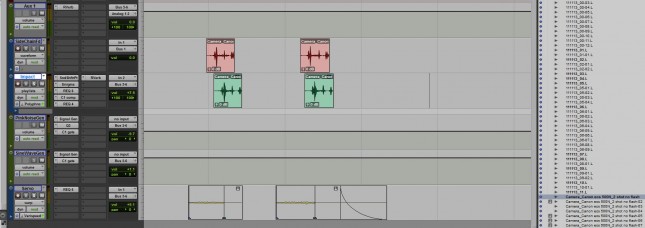Mikkel Nielsen, founder of Sonic Salute, recently released a new library called “Analog Cameras.” In his own words:
What started out as a somewhat smaller camera sound effects recording project, quickly evolved into an obsessive need to find new cameras with different sounding shutters and winders.
Every fleemarket, and camera entusiasts gathering, were thoroughly scanned for more, more more…
The obsessive hunt has resulted in a well produced library. And at the price of $40 dollars for 99 files culled from a stock of 17 cameras, it’s well worth your attention. Let’s dig into the sounds a little deeper…
Click here to listen to a demo of the full library.
[note: I apologize for making you click out through a link, but WordPress keeps dumping the SoundCloud embed code. Additional note: Mikkel has added a noise sample into this demo file as a form of copy protection.]
As you may notice from the SoundCloud file above, the library has a heavy focus on shutter and servo sounds. There’s a nice variety of these with multiple takes and unique behaviors between cameras. You’ll also find a number of well performed camera handling sounds. Within those handling sounds, the files that drew my attention the most were the opening and closing of the film compartment. While those recordings do sound very crisp and clean, I really would have liked to have heard some film loading and unloading to go with them. While in no way a deal-breaker, I do feel it was a missed opportunity. There are a few instances in the library where a hint of reverb works its way into the mix, but these are few and far between and at a level where it would easily be buried in even a quiet mix. I would say that the overall control of reverb in these recordings is commendable, and something not easily done when recording transient heavy sounds indoors.
When familiarizing myself with the library, I thought it would be useful to explore an approach beyond its literal application. I view everything that goes into my library as a potential ingredient in the audio cookbook, and finding new recipes is always a fun, and useful, exercise. I picked two approaches to try out. The first was an exercise in random mash-ups, while the second was a targeted morph of a select sound.
For the unholy soup, I turned to Izotope Iris and selected some very tight frequency groups within the individual files. Here’s a screenshot of the layering, and the resultant sound I recorded in Pro Tools.
Click here to listen to the Iris patch.
The thin vertical slice in the Canon servo movement file provided the the odd rhythmic static-like clicking sound, while the tonal selections in the Fujica timer provided the bed drone. The Zeiss housing sounds provided the watery accents in the file. There’s a little bit of processing going on over these sounds too. The processing was set up in “Send” mode to give me some finer controls over each element.
The distortion, chorus and reverb helped glue the sounds together. Since initially toying around with this patch and recording the audio file, I’ve modified the key mapping so that I can control when the watery accents occur. It’s got a slightly eerie quality that I like. I have no idea when I might use this patch, but I’ll keep it in my presets. You never know when you’ll find the perfect opportunity for an unlikely sound.
My next experiment was with a shutter and servo file. I wanted to try taking this sound and turning it into a mechanical (or robot) footstep.
Here’s the before and after.
Original Camera file on SoundCloud. [posted with permission]
Processed footstep sound on SoundCloud.
And here’s how I put the sound together.
The shutter became my impact, or footstep, sound. I first used elastic audio to slow it down and space out the clicks, then pitch shifted it down with Waves Soundshifter. Next came Waves Enigma to give it a bit of a metallic ring, followed by a combination of EQ and compression to shape the sound a bit more. The reverb that follows all that was a very mild setting, just to give it a bit of a tail out. I duplicated the files on another track so that I could slip them in time and feed a pair of side chain gates such that they would open in time with the original shutter sound. These gates controlled separate sine wave and filtered pink noise generators. These generators were how I filled out those impacts and gave the sound a bit more body. The servos just took a little bit of stretching with the Varispeed plug-in of elastic audio, and some EQ to better match them to the sound of the impacts. Top it off with a little bit of master bus reverb to put it in a space, and voila! …walking robot.
After taking some time with the library for these experiments, I sent Mikkel a few questions about the library.
DS: What was the attraction in building a library of camera sounds, and what was your design philosophy behind it?
MN: During this past summer I needed to record some camera clicks and flash sounds for sound designer Peter Albrechtsen from Tonemasters in Denmark. He was designing sound for a documentary about a famous Danish comedian. Peter needed material for camera flashes, but also wanted some new shutter sounds.
From there on, I fairly quickly found some 1980’s reflex cameras at a flee market. They were completely busted for taking pictures, had no lenses, and one of them had no bottom plate attached to it, meaning that I could watch the entire mechanism work as the camera was operated. I found this physical cooperation by so many small parts very fascinating to watch. The winders and shutters worked perfectly, and had that nice and classic, almost relaxing sound to them.
I recorded these, and forgot about cameras for a while, until I attended another flee market some weeks later. Here, I couldnt resist buying some more cameras which sounded really nice. It was actually this Sunday I realized that It was turning into an addiction. I just needed more clicks, winders, lens shifts, etc.
When I had emptied all nearby flee markets, I connected with a local camera shop owner who had some cameras that I just wouldn’t have had a chance to get my hands on otherwise. These cameras were recorded in the shop, in a storage room, away from customers and street noise.
I now had a good deal of different sounding cameras and thought that it would be nice to make a library out of it. My self-made rules (philosophy) behind this library, was to record the different mechanisms of analog cameras only, or at least cameras which had an analog shutter, or button etc. More importantly, I think, the actual sounds had to bring that special feeling inside my head (an almost tinkling sensation) when I heard the opening/closing of the film compartment, or the winder and shutter moving.
DS: I’m assuming you did most of the recording for this library indoors. You did a superb job capturing the sounds with very little reverb. That can be challenging to do with transient sounds that have a high percentage of high frequency spectral content, even in well designed rooms. What techniques did you use to reduce reverb in your recordings?
MN: Thanks a lot Shaun. Yes I did do all recordings inside my studio.
I live in a city, where it is possible to record quiet sources without getting too much noise from the street into the recordings. Even so, I planned alot of the sessions late at night to get the best results. Furthermore I had setup some baffles on both sides of the microphone. This helped a lot too. I recorded directly to a Sounddevices 702, and had no computer or interface turned on at the same time. Which for obvious reasons, would have ruined the recordings.
My room is not that treated. I have 60cm by 120cm Rockfon frames on the walls, and a carpeted floor. Besides this I got alot of cardboard boxes filled with all sorts of weird stuff for making weird sounds, behind my console, as well as behind me and beneath an office table. This random placing of things works well, I think.
Some recordings had a certain buzz noise to them (like the ones recorded in the camerashop). These were noise reduced to get rid of that.
DS: In some of your recordings, you have housing opening and closings that sound very much like the film compartment. Had you considered including any film handling or loading sounds in this library? There were a couple times where I wanted to hear that with those housing sounds.
MN: Yes I did consider getting some sounds of the film handling, and tried it. I’m just not very photo savvy, to say the least. The process took too long and sounded clumsy, not very pro.
DS: You used a hydrophone as a contact mic. How did that work out? Where did it give you better results than the other mic you used in this library, a Sennheiser MKH416?
MN: I used the hydrophone for the flash charges and releases, as these sounds were really quiet. The Sennheiser MKH416 didnt cut it. I was recording more noise than actual charge signal. Also, the charge was sort of inside the flash unit, and the hydrophone picked this up far better. Other then that, the 416 worked flawlessly for this library. It has been, and still is, a workhorse for me. Both in and outdoor.
DS: Is there anything you learned in the course of putting together this library that will be useful on your next project?
I have spent alot of time experimenting with different microphone postions, distances, and how to get the best results out of my room and equipment. Recording these sorts of metallic sounds brought its share of challenges. One camera sounded much better very close miked, while another sounded much too harsh when miked like this and needed more space and air around it.
Another thing I learned in this process, was how to use the surrounding objects (shelves, doors, cardboard boxes, etc.) to minimize noise. In the camera shop there was quite alot of traffic noise, customers talking, and machinery going. I was forced to get creative. So I entrenched myself way back in the storage room, placed some boxes on both sides of the microphone and used my own body as a baffle infront of it. Finally the owner closed the door to the storage, and all that was left was a low hum.
DS: Thanks for the details, Mikkel.
MN: Thank you very much, Shaun, and everyone else at Designingsound for giving me the chance to explain the process.
A review copy of the library was provide by Mikkel Nielsen at Sonic Salute.




[…] recently did a review of Sonic Salute’s Analog Cameras library. Mikkel Nielsen has been a busy man apparently, because he’s just released a new library […]